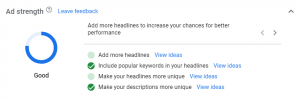Google recently announced that Responsive Search Ads (RSAs) will officially become the default ad type for Search campaigns in Google Ads, although expanded text ads can still be created. So what are the implications and benefits of using RSAs?
RSAs allow advertisers to input multiple headlines and ad copy variations so that Google Ads then uses machine learning to determine which variations to use, based on which combinations perform best in relation to what queries people are searching for. (The Ad strength score lets search marketers understand how to improve their RSAs for better performance).
Google states that machine learning and artificial intelligence (AI) improves campaign performance and outcomes. It does this by matching the best ad variation with each search, using data from ad performance segmented by query. In this way responsive ads give advertisers the best chance to be competitive in the changing search marketing landscape.
Many PPC marketers note that RSAs often outperform the traditional text ads, although that varies based on individual implementation. Search Engine Land’s analysis frames the debate well: “RSAs are capable of being great ads and they deserve a chance in any account. They’re not a magic wand for ad optimisation and still require human optimisation.”
Google recommends that advertisers not using RSAs currently consider the following best practices:
- Use Ad strength when writing your headlines and descriptions to understand the effectiveness of your ads.
- Take advantage of location insertion and countdown customisers to show ads that are relevant and meaningful to your customers.
- Use Smart Bidding and broad match keywords with responsive search ads to help optimize the performance of your ads while maximising their reach.
- Review cross-campaign asset reporting to understand which creative assets resonate most with the customers.
Here are some more tips and best practices for RSAs:
- Responsive Search Ads perform best with more headlines & descriptions.
- For best performance, highlight something different in each headline & description.
- You can pin headlines & descriptions to specific positions in Responsive Search Ads. However, pin very sparingly!
- You can still keep your Expanded Text Ads and create more of these based on the best performing combinations from the RSAs.
- Test only one Responsive Search Ad per Ad Group.
- Use your top-performing static ads to come up with RSA assets.
More details on those best practices can be found here.
 A good feature of RSAs is the Ad Strength Indicator, which measures a combination of relevance, quantity and diversity of the ad copy in those ads. It will then give a score ranging from ‘Poor’ to ‘Excellent’ and combine this with actionable feedback such as ‘Add More Headlines’, or ‘Make Your Description Lines More Unique’. From here, advertisers can then click on ‘View Ideas’ to get inspiration on what more could be done to help improve the score, and then apply if needed.
A good feature of RSAs is the Ad Strength Indicator, which measures a combination of relevance, quantity and diversity of the ad copy in those ads. It will then give a score ranging from ‘Poor’ to ‘Excellent’ and combine this with actionable feedback such as ‘Add More Headlines’, or ‘Make Your Description Lines More Unique’. From here, advertisers can then click on ‘View Ideas’ to get inspiration on what more could be done to help improve the score, and then apply if needed.
The Ad Strength Indicator is useful to ensure the ads are working as hard as possible. In theory if the Headlines/Description Lines are more unique the relevance increases which improves your Click Through Rate which then improves your Quality Score, CPCs and performance.
Another useful tip is to take the best performing ads from an RSA campaign and use them as traditional Expanded Text Ads. In this way it’s possible to use the RSAs for testing. Combinations of which ad copy work best in the real world can then be seen and then that same ad can be created for use in a standard campaign.
For more information or help with Responsive Search Ads, please get in touch.
